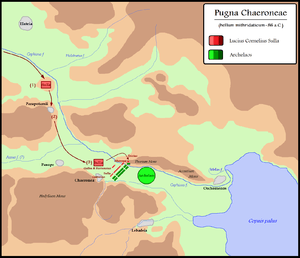Battle of Chaeronea (86 BC)
| Battle of Chaeronea | |||||||
|---|---|---|---|---|---|---|---|
| Part of the First Mithridatic War | |||||||
 | |||||||
| |||||||
| Belligerents | |||||||
| Roman Republic | Pontus | ||||||
| Commanders and leaders | |||||||
| Sulla | Archelaus | ||||||
| Strength | |||||||
| 40,000 | 120,000 | ||||||
| Casualties and losses | |||||||
| 12 (figures are greatly disputed) | 110,000 (figures are greatly disputed) | ||||||
| ||||||
For the earlier battle, see Battle of Chaeronea (338 BC)
The Battle of Chaeronea was the victory of the Roman forces of Lucius Cornelius Sulla over Archelaus near Chaeronea, in Boeotia, in 86 BC during the First Mithridatic War. This battle is described in three ancient texts, although the accounts differ slightly. The description of the battle is found in Appian's Mithridatic Wars, Sections 42-43, Frontinus' Stratagems,[1] as well as Plutarch's Life of Sulla, chapters 17-19.
Forces
Appian tells us the Pontic commander Archelaus had Thracian, Pontic, Scythian, Cappadocian, Bithynian, Galatian, and Phrygian troops, numbering near 120,000. Each nationality was commanded by their own general, all of whom answered to Archelaus as commander-in-chief.
Sulla's forces consisted of several legions of Roman troops, as well as Greeks who had defected to the Roman side. They numbered about 40,000.
Geography
The terrain of the plain of Chaeronea was integral to the beginning and end of the battle. Sulla consistently refused to offer Archelaus battle until he found his enemy encamped in terrain favourable to his Roman force. Archelaus' camp was in a rocky region near a broad plain at the bottom of a slope. Sulla took advantage of the favourable ground and arrayed his forces before the plain on the hill, with a tactically advantageous view into the camp. Plutarch states that in this way Archelaus had no choice but to array his army on the plain, or risk being stoned to death by the Romans from above. There was no other way out of the battle since the camp was surrounded by rocks; Archelaus had to array his army before the Romans on the plain below the hill. Moving his army out of the camp onto the rocks would have disordered their formations, and prevented their horses and chariots from being effective.
Battle
As the Mithridatic forces formed up, Sulla hastily advanced upon them, closing the gap between the armies, thereby rendering the deadly scythed-chariots useless. Regarding this instance, Plutarch says:
[Sulla] robbed the scythe-bearing chariots of their efficiency. For these are of most avail after a long course, which gives them velocity and impetus for breaking through an opposing line but short starts are ineffectual and feeble, as in the case of missile which do not get full propulsion. And this proved to be true now in the case of Barbarians. The first of their chariots were driven along feebly and engaged sluggishly, so that the Romans, after repulsing them, clapped their hands and laughed and called for more, as they are wont to do at the races in the circus.
Appian and Frontinus add that the chariots were in fact destroyed by the light armed infantry, who assailed the Mithridatic unit with missiles.
The infantry then engaged each other in the center. Archelaus sought to use his superior numbers to his advantage as quickly as possible and extended his right wing (the Roman left) to envelop the Romans. Seeing this, the legatus (Roman lieutenant) Hortensius led his troops to counter this move, and were slowly separated from the rest of the Roman force as they spread to meet the enemy. Archelaus charged this Roman detachment and surrounded them.
At this time, Sulla was stationed on his right wing which had not yet been engaged by the Mithridatic forces. Learning of Hortensius' dire situation, he made for his left wing to help out. Archelaus noticed the dust cloud and the standards of the Roman commander approaching and abandoned his position in order to attack the now commander-less Roman right wing.
Thus, the threat was lifted from Hortensius' forces, but the other Roman legate, Murena, simultaneously found himself in trouble, being attacked by the elite bronze-shields unit of the Pontic army. Sulla heard the pleas for assistance echoing on the hills and decided to send Hortensius' force to Murena, and lead his own unit and the fifth cohort back to his post on the right wing.
Sulla found his right wing standing firm against Archelaus' personal onslaught, and with his arrival routed the Mithridatic forces from his right wing. At about the same time, the Roman forces in the center led by Murena, who was actively encouraging his men in battle, also managed to rout the Mithridatic force. Victory was Sulla's.
Aftermath
As the Mithridatic forces fled back towards their camp, they were easily slain, having been completely disordered by the uneven terrain of their path of retreat. Appian claims that Archelaus blocked his soldiers' entry into the camp and forced them to turn and face the Romans. They did so, but could not withstand the Roman impetus.
Appian and Plutarch claim that only 10,000 of the enemy forces survived and escaped to the nearby town. They add that 14 Romans were not accounted for at the end of the battle, two of which returned at nightfall, making the Roman casualty count an unbelievable 12 soldiers. While these figures are obviously inaccurate, as the close range nature of fighting between the infantry forces must have caused heavier Roman losses, nevertheless, the Pontic forces undoubtedly suffered disproportionately heavier casualties.
The battle would be followed by the Battle of Orchomenus after Archelaus was reinforced by eighty thousand fresh troops under Dorylaeus.